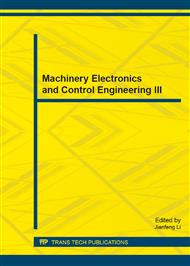[1]
S Parkvall, E Dahlman, A Furuskar, Y Jading, M Olsson, S Wanstedt, K Zan LTE-Advanced - Evolving LTE towards IMT-Advanced, in IEEE 68th Vehicula Technology Conference, 2008. VTC 2008-Fall, Calgary, Canada, 1–5 (2008).
DOI: 10.1109/vetecf.2008.313
Google Scholar
[2]
J.E. Wieselthier, G.D. Nguyen, and A. Ephremides. On the con-struction of energy-efficient broadcast and multicast trees in wireless networks. InProceedings of IEEE Infocom, March (2000).
DOI: 10.1109/infcom.2000.832232
Google Scholar
[3]
L Correia, D Zeller, O Blume, D Ferling, Y Jading, I Godor, G Auer, L Perre, Challenges and enabling technologies for energy aware mobile radio networks. IEEE Commun Mag. 48(11), 66 –72 (2010).
DOI: 10.1109/mcom.2010.5621969
Google Scholar
[4]
M Dohler, Y Li, Cooperative Communications, Hardware, Channel & Phy , Wiley, UK, (2010).
Google Scholar
[5]
Y Chen, S Zhang, S Xu, G Li, Fundamental trade-offs on green wireless networks. IEEE Commun Mag. 49(6), (2011).
DOI: 10.1109/mcom.2011.5783982
Google Scholar
[6]
Can Sun, and Chenyang Yang , Is Two-way Relay More Energy Efficient?, IEEE Globecom 2011 proceedings.
DOI: 10.1109/glocom.2011.6133966
Google Scholar
[7]
Can Sun and Chenyang Yang, Energy efficiency analysis of one-way and two-way relay systems EURASIP Journal on Wireless Communications and Networking, February (2012).
DOI: 10.1186/1687-1499-2012-46
Google Scholar
[8]
Matthew Nokleby and Behnaam Aazhang, User Cooperation for Energy-efficient Cellular Communications, IEEE ICC 2010 proceedings.
DOI: 10.1109/icc.2010.5501888
Google Scholar
[9]
Huan Yu, Ruogui Xiao, Yunzhou Li, Jing Wang, Energy-Efficient Multi-User relay networks, Wireless Communications and Signal Processing (WCSP), 2011 International Conference, 9-11 Nov. (2011).
DOI: 10.1109/wcsp.2011.6096682
Google Scholar
[10]
Yates, R.D., Forwarding Strategies for Gaussian Parallel-RelayNetworks, Information Theory, 2004. ISIT (2004).
Google Scholar
[11]
Ning Hu, Xiang Chen, Xiaofeng Zhong , Ben Slimane, Yun zhou Li , and Jing Wang, Energy-Efficient Relaying Strategy with Network Coding in Two-Way Parallel Channels, International Scholarly Research Network, ISRN Communications and Networking, (2011).
DOI: 10.5402/2011/186783
Google Scholar
[12]
M. Chiang, C. W. Tan, D. Palomar, D. O'Neill, and D. Julian, Power control by geometric programming, IEEE Trans. Wireless Commun., vol. 6, pp.2640-2651, July (2007).
DOI: 10.1109/twc.2007.05960
Google Scholar
[13]
Stephen Boyd and Lieven Vandenberghe, Convex Optimization, Cambridge University Press, (2004).
Google Scholar
[14]
M. Grant and S. Boyd, CVX: Matlab software for disciplined convex programming (web page and sof tware), http: /stanford. edu/ ~boyd/cvx, Feb. (2008).
Google Scholar


